The first Star Trek pilot, The Cage, was produced in 1964. To celebrate its fiftieth anniversary, this December we are reviewing the second season of the original Star Trek show. You can check out our first season reviews here. Check back daily for the latest review.
The Gamesters of Triskelion is not a great episode of Star Trek. Although filmed after Obsession, even if the production order lists it before that episode, The Gamesters of Triskelion feels like we’re watching producer John Meredyth Lucas finding his feet. It’s an episode that feels light and looks relatively cheap, formed from a collection of clichés that would already be familiar to Star Trek fans or fans of pulp science-fiction.
Perhaps the best thing that can be said about The Gamesters of Triskelion is that it has a decidedly pulpy charm to it. The entire episode looks like it was lifted from the cover to some trashy paperback, and the plot is recycled from stock science-fiction concepts and themes. While this isn’t enough to sustain an entire fifty minutes of television, it does allow the episode to feel a little distinctive and memorable… if not necessarily in a good way.
It is amazing how much of the franchise’s memorable iconography and imagery comes from weaker episodes of the classic Star Trek. It’s a testament to the show’s production design team, that could always find a way to make Star Trek look impressive, even on a tight budget and a short schedule. There’s also something enduring about the bizarre images that Star Trek could throw up on screen, even when the scripts were lacking; from space!Lincoln in The Savage Curtain to half-black/half-white racism in Let That Be Your Last Battlefield.
Of course, there are episodes that are both great and iconic at at the same time, like Mirror, Mirror. Still, rewatching the show, it is hard to believe just how much of the popular perception of Star Trek comes from episodes that are of… questionable quality. After all, The Gamesters of Triskelion seems to have made an impression. It seems to be a go-to reference for Matt Groening’s television shows.
It was the Star Trek episode that The Simpsons chose to reference in Deep Space Homer, right down to the distinctive set design and a NASA official yelling, “I’ll wager 400 quatloos on the newcomer!” The design of the “brain spawn” on Futurama seems influenced by the design of the eponymous gamesters here. The Gamesters of Triskelion is really the perfect cocktail of Star Trek clichés and memorable images.
The Gamesters of Triskelion looks like a pulpy piece of science-fiction from the late fifties or early sixties, filled with primary colours and elaborate fight sequences. It is a story about slavery and oppression, in which a handsome Earth man is abducted to another planet so that he may teach a beautiful woman about this thing called love. The beautiful alien has striking green hair and a costume that seems to be made of tinfoil. There are ancient ruins and obvious soundstages. There are creepy overseers and monstrous aliens. The whole thing is overseen by three brains in a jar.
The episode seems more preoccupied with the next fight sequence than with logical plot developments. Gerard Fried’s iconic fight music from Amok Time gets yet another go-around, as Kirk and his away team find themselves fighting for their lives against a number of aggressive aliens. Fred Phillips’ Andorian makeup reappears here, but the production design of The Gamesters of Triskelion seems to hark back to classic science-fiction archetypes – the burly giant Kloog, the space-age Roman Lars, the bald cloak-wearing psychic Galt and the green-haired space babe Shahna.
Interestingly, and perhaps tellingly, The Gamesters of Triskelion marks a return to the aesthetics of the first season. The episode presents a planet that is a graveyard, occupied by ruins of an ancient civilisation that collapsed in on itself long before mankind reached the stars. It recalls the eerie sense that space is a graveyard, an element of early stories like The Cage or Charlie X or The Man Trap or What Are Little Girls Made Of? or even The Squire of Gothos.
There was a sense in those early episodes that mankind had arrived late to the party, stepping out into a once-vibrant cosmos that was now decaying and collapsing. The gamesters were once a mighty civilisation. Now all that remains are three brains in a jar, gambling on fights to the death. This feels like a rather conscious step backwards for Star Trek, which had spend a significant portion of the late first and early second season suggesting that space was populous and full of activity from powers like the Romulans or the Klingons.
It’s possible that this step backwards is a result of the changes taking place behind the scenes. After all, it was Gene L. Coon who had overseen a lot of the development of the wider Star Trek cosmos. After he left, it did seem like the show slipped backwards a little bit. With its space-age vampire preying on witless Starfleet officers, Obsession seemed to hark back to The Man Trap, the first Star Trek episode to air. By Any Other Name would see the crew revisiting the galactic barrier for the first time since Where No Man Has Gone Before, the first episode produced.
There’s a sense that this is Star Trek trying to find its footing again, after all manner of changes behind the scenes. It’s an episode packed with elements that feel familiar, with no real sense that the series is pushing itself. The crew fight to the death! Non-corporeal bored aliens! Kirk seduces a beautiful babe! Freedom is good! Slavery is bad! Action! Dramatic music! A significant section of the episode is given over to time-eating scenes on the bridge of the Enterprise as Spock, McCoy and Scotty argue about what to do. (Answer: try to find the missing crew members.)
The most interesting plot element of The Gamesters of Triskelion is the implied criticism of television and spectacle… and maybe gambling. The gamesters are effectively couch potatoes. “We have found athletic competitions our only challenge,” they tell Kirk, “the only thing which furnishes us with purpose.” Kirk suggests that this is a flaw humanity shares, advising them, “My people pride themselves on being the greatest, most successful gamblers in the universe. We compete for everything. Power, fame, women, everything we desire, and it is our nature to win.”
Much is made of the entertainment of the gamesters, both inside and outside the ring. When Kirk begs for mercy for Shahna, the gamesters spare him – because the drama engaged them. “Captain, you do indeed present many surprises. Because you have amused the Providers, there will be no punishment.” The climax of the episode features the gamesters broadcasting the fight, as if hoping to share their sport with the universe. “Because you wager your skill for all your people, they will be permitted to watch the outcome of the game on the ship’s viewscreen.”
However, even that was done much better in Bread and Circuses – another episode about how mindless (and cruel) entertainment can be used to hold a society back from reaching its potential. However, while Bread and Circuses made a few sly swipes at NBC, The Gamesters of Triskelion hedges its observations in the most banal and generic manner possible. Of course slavery and fights to the death are bad, but that is all that exists of the gamester culture.
It doesn’t help that the script mangles a lot of these themes. Most obviously, Kirk seems horrified by the idea of enslaving all of these races for the amusement of the gamesters. This makes sense. Slavery is bad, after all. However, he is perfectly happy to murder them as part of his final gambit. Of course, the gamesters force his hand, but the episode is too swept up in the excitement of the brawl to give it any real thought.
“An opponent must be killed to be removed from the game,” the gamesters tell him. “If only wounded, he is replaced by a fresh thrall. Is that clear, Captain?” It seems like Kirk might have tried to haggle this with the gamesters – insisting on a limit to the number of tag-ins or such. Instead, Kirk simply replies, “Yes, that’s clear.” Kirk is pretty bloodthirsty during the fight – he only seems to hesitate when Shahna is used against him.
There’s also a rather uncomfortably imperialist subtext to the episode, arguably one that comes embedded in the pulpy tropes. Stating his terms to the gamesters, Kirk reflects, “You will educate and train them to establish a normal self-governing culture.” While this is understandable, Kirk adds, “We have done the same with cultures throughout the galaxy.” It makes it sound like the mission of the Enterprise is not to seek out new civilisations, but to spread the Federation’s idea civilisation, building societies in their image.
Of course, this comes with the territory. The aesthetics of The Gamesters of Triskelion come right out of a science-fiction b-movie, with Kirk even teaching an alien space babe about love. “What is beautiful?” Shahan actually asks at one point. “What is love?” she asks later on. The Gamesters of Triskelion plays into the same sort of fantasy as Edgar Rice Burroughs’ John Carter of Mars – the story of a hero abducted to a strange land who takes the opportunity to hook up with an exotic slave girl and to oppose tyranny. (John Carter of Mars was also fond of exotic gladiatorial combat.)
It feels like The Gamesters of Triskelion embraces the idea of a white man remaking an alien culture is his own image a little too quickly after A Private Little War. Similarly, the episode’s casual sexism feels a little out of place as well. A Private Little War featured a sexual assault and murder towards the end, as a way of punishing a female villain. The Gamesters of Triskelion places an implied attempted rape at an act break, as an incredibly cheap way of drumming up tension.
Uhura is assaulted by Lars in her cell, in a sequence shot in silhouette. “What are you doing?” she protests as he enters her cell. “Get out!” Lars matter-of-factly states, “I have been selected for you.” Despite his choice of euphemism, it is clear what is going on. As Kirk begins to freak out, the tension mounts, the music builds… and the camera cuts to black as we zoom in on William Shatner’s face.
This is a tasteless sequence in a number of ways. For one thing, the scene is constructed more around Kirk’s helplessness than anything concerning Uhura. Kirk is the character who gets the big reaction shots, and it is made perfectly clear that Kirk’s freakout as he tries to protect his officer is as important (if not moreso) than anything that actually happens to Uhura. Once the episode has got an act break out of Lars’ attempted rape, it is never mentioned again.
As much as the episode places Uhura in peril by having her “selected” for Lars, it is telling how The Gamesters of Triskelion treats potential “selection” for the two male members of away team. Chekov’s potential “selection” is treated as a joke, because the threat of sexual assault is apparently a thrill when it happens to a woman, but hilarious when it happens to a man. Shahna’s potential “selection” for Kirk is treated as a love story waiting to happen. “I must say, I’ve never seen a top sergeant who looked like you,” he quips.
The episode’s fixation on “selection” is itself quite unsettling. The idea of breeding slaves does underscore the horror the practice – the idea that these people are nothing but livestock to those who own them. However, the fact that The Gamesters of Triskelion features no children (and no pregnant characters) suggests that the episode is more interested in using “selection” to generate some cheap laughs and even cheaper thrills, rather than to communicate the horror of slavery.
There’s also the unavoidable reality that The Gamesters of Triskelion feels rather cheap. There are a number of obvious elements that make it seem like The Gamesters of Triskelion is cutting corners, even beyond the script assembled from recycled parts. Rather than the expensive transporter effect, the gamesters ensure that characters travel via much cheaper jump cut. The backdrop seen during Kirk’s conversation with the gamesters is very clearly the same one used in The Devil in the Dark.
It doesn’t help that Shatner is in full scenery-chewing mode. To be fair, Shatner’s gloriously over-the-top performance is one of the highlights of the episode, but it’s a performance that draws attention to the cheesy artifice of the whole production. This is an episode in which Kirk seduces a green-haired lady in a space bikini before engaging in a battle royale against a whole host of b-movie aliens. Shatner’s performance is a cherry on top, suggesting that the actor isn’t taking the whole thing entirely seriously.
It is worth noting that The Gamesters of Triskelion could have been the last episode of Star Trek. The show was in a precarious position at this point in its run. At one point, word even reached the set that Star Trek had been cancelled – that NBC would not be continuing the show. As guest star Angelique Pettyjohn told the fan magazine Enterprise Incidents:
The producer came in during lunch time and made an announcement to the cast and crew that he was sorry to say that the network had cancelled the series, and then everyone was very depressed. And so the last two days of shooting everyone was king of down around the set because of that and because they all loved working together so much. On my last day of shooting I had a particular speech where I said, ‘Goodbye Jim Kirk, I will watch the lights in the sky and remember;, and I had several tears in my eyes and those tears were real at the time because I was thinking, as my motivation as an actress that seriously it was goodbye Star Trek. I will watch the film and the lights in the sky and I will remember this experience with all of you, and it meant a great deal to me and I cried at that and that’s how I meant it because I knew that the series wasn’t going to be shooting any more.
It does lend Shahna’s tearful goodbye a bit more resonance, but it is also a terrifying thought. Even without the difficulty of syndicating a thirty-six episode show, which would likely have killed any chance of the repeats that helped Star Trek secure its audience into the seventies and beyond, it’s depressing to imagine the production shutting down on The Gamesters of Triskelion.
Of course, the show did close on The Turnabout Intruder at the end of the third season, which can hardly claim to be a much better episode. However, that episode came at the end of a long and painful season where the series stumbled and faltered under a variety of factors. In contrast, the second season of Star Trek had been been bold and creative and ambitious, and it would be again. Closing out on a piece of dull pulp like The Gamesters of Triskelion seems like the worst place to cut the second season. Well, except for after The Omega Glory and Assignment: Earth.
The Gamesters of Triskelion is memorable. It is very pulpy science-fiction, harking back to fifties and sixties space operas and planetary romances. While none of the elements coalesce into a good or interesting story, the visuals do linger. Which is something.
You might be interested in our other reviews from the second season of the classic Star Trek:
- Catspaw
- Metamorphosis
- Friday’s Child
- Who Mourns for Adonais?
- Amok Time
- Supplemental: Spock’s World by Diane Duane
- The Doomsday Machine
- Supplemental: New Visions #3 – Cry Vengeance
- Wolf in the Fold
- The Changeling
- The Apple
- Supplemental: (DC Comics, 1984) #43-45 – The Return of the Serpent!
- Supplemental: (IDW, 2009) #13 – The Red Shirt’s Tale
- Mirror, Mirror
- Supplemental: Deep Space Nine – Crossover
- Supplemental: New Visions #1 – The Mirror, Cracked
- Supplemental: (DC Comics, 1984) #9-16 – New Frontiers (The Mirror Universe Saga)
- Supplemental: Mirror Images
- Supplemental: Mirror Universe – The Sorrows of Empire by David Mack
- Supplemental: (IDW, 2009) #15-16 – Mirrored
- The Deadly Years
- I, Mudd
- Supplemental: (Gold Key) #61 – Operation Con Game
- Supplemental: (DC Comics, 1984) #39-40 – The Return of Mudd
- The Trouble With Tribbles
- Supplemental: The Galactic Whirlpool by David Gerrold
- Supplemental: Alien Spotlight – Tribbles
- Bread and Circuses
- Journey to Babel
- A Private Little War
- The Gamesters of Triskelion
- Obsession
- The Immunity Syndrome
- A Piece of the Action
- By Any Other Name
- Return to Tomorrow
- Patterns of Force
- The Ultimate Computer
- The Omega Glory
- Assignment: Earth
- Supplemental: Assignment: Eternity by Greg Cox
- Supplemental: (DC Comics, 1989) #49-50 – The Peacekeepers
- Supplemental: (IDW, 2008) Assignment: Earth
Filed under: The Original Series | Tagged: cancellation, Gambling, gamesters, gamesters of triskelion, gene roddenberry, john meredyth lucas, margaret armen, pulp, sci-fi, science fiction, shanha, Shatner, star trek, Television, to the death, tos, what is love? |















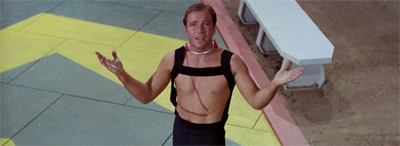
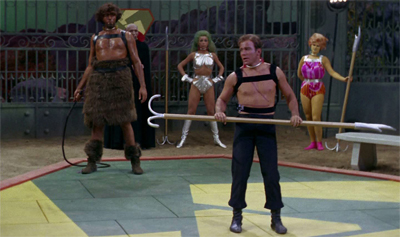
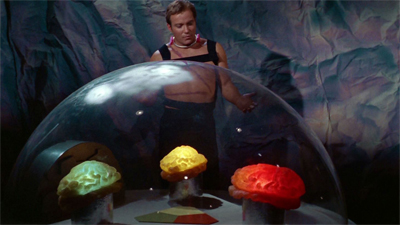

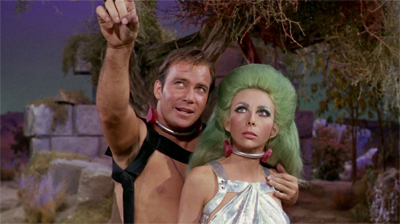




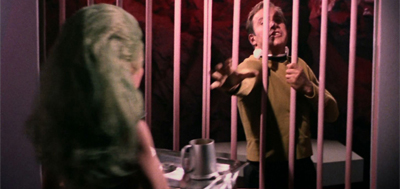
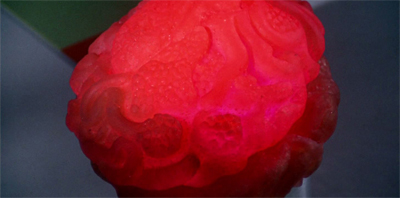

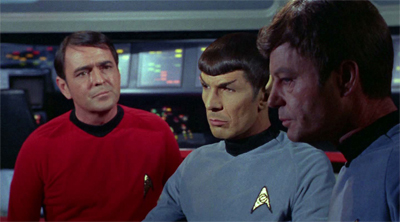





A few months ago I had an opportunity to re-watch “The Gamesters of Triskelion” for the first time in many, many years. And I think that from now on, going forward, I am inevitably going to think of this episode as “the one where Captain Kirk gets it one with Lady Gaga” 🙂
The Gamesters of Triskelion is really the perfect cocktail of Star Trek clichés and memorable images.
LOL! You are NOT kidding! Seriously, even before reading your review, I thought of this episode as the quintessential example of by-the-numbers Star Trek: The Original Series…
1) The crew of the Enterprise become the pawns of incredibly ancient alien beings with seemingly god-like powers
2) Kirk meets a sexy, half-naked alien woman who he seduces in order to gain information and foment rebellion
3) The entire crisis is resolved in a huge, dramatic fight scene between Kirk and a group of alien gladiators
4) Having overthrown a corrupt and totalitarian regime, Kirk promptly skedaddles away on the Enterprise, leaving behind the denizens of the planet to have to pick of the pieces & rebuild civilization all on their own, in the process also abandoning the woman whose heart he broke
I guess you could offer up the excuse you’ve cited before, that “The Gamesters of Triskalon” was just one more episode in a TV show that the creators figured would get viewed once or twice and then forgotten about by the general public, as opposed to becoming an entry in an iconic series that is endlessly re-watched by avid fans half a century later.
“The Gamesters of Triskelion” is very much a product of its time, when TV was both plot-driven and extremely episodic. In a way, it is sort of unfair to judge it by today’s standards, when so much of television is character focused and driven by a larger arc. If an episode like this aired in 2014, I expect many viewers would be wondering if any of these events would be followed up a season or so from now, if we’d be re-visiting Triskelion to see the consequences of Kirks actions. Did the Providers really try to organize the former Thralls into a new civilization, and if so were they able to make it functional? Has Shahna moved on with her life, or is she still pining for Kirk?
I guess this just goes to show how much audience expectations have changed since the late 1960s. Back then, most viewers probably said “Oh, that was cool. I wonder where the Enterprise is going to end up next week?” Nowadays, the audience is more likely to be left asking “Wait, that’s it? That’s the end? But what happens next?”
It’s certainly interesting that this episode reveals just how much of a product of its era the original Star Trek was, and enables us to see how much the medium of television has transformed in the intervening decades.
My apologies for the looooong reply. And I hope that you do not mind all of my recent comments. Your blog is really thought-provoking.
Of course I don’t mind your comments! Glad to have them! Apologies that it takes me so long to reply. As you may have gathered, I tend to schedule posts in advance so I’m away from the actual site for extended periods.